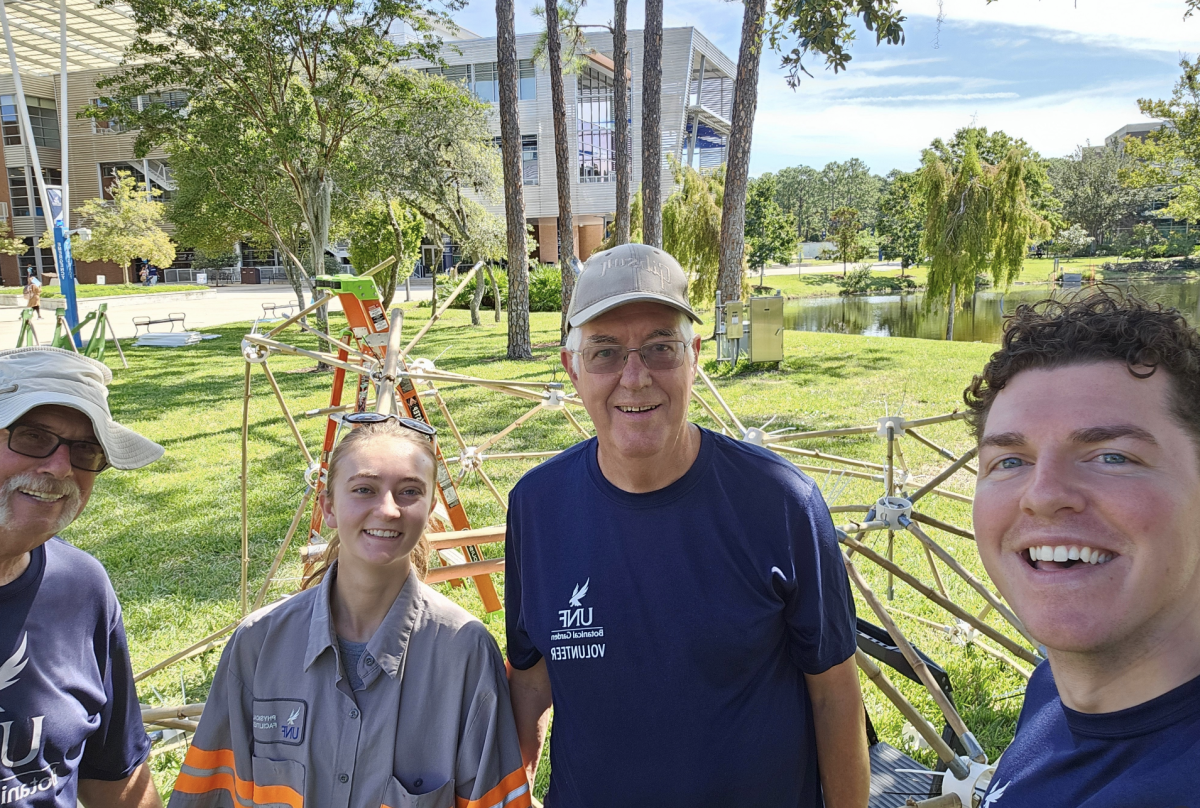Sweet Pete’s is Hemming Plaza’s new kid on the block. The historic multi-story Seminole Club building, underneath the whizzing Jacksonville Skyway, has been converted into an emporium of treats, varying in style, color and taste. White clothed tables sit on a wrap-around porch as small parties sit and chat while drinking candy-inspired cocktails. Jazzy grooves dip into the warm air while silverware clink against plates. Upon entering the foyer, a display featuring candy-covered apples, chocolate bunnies and edible high-heel shoes line the wooden hallway. The Candy Apple Cafe is on the left, while chocolate truffles and rich mochas encased in glass fill the room on the right. Even on a Wednesday evening, a presumably quiet time for downtown Jacksonville, Sweet Pete’s is bustling with activity.
A dark wooden staircase leads the eyes to another level of sweet smelling visuals. The first of three rooms is the ice cream parlor, where flavors like Thai ginger and green tea sit beside classics like strawberry and cookies n’ cream. Hard candies, jellies, taffies, and gums sit atop tables in plastic bins on a black and white checkered floor in the other two rooms. Colorful chandeliers, zebra striped ceiling lights and paper Easter eggs hang above the customers.
One can snack on “strawberry rocks,” a Sweet Pete’s original hard candy, while watching workers in red shirts slice a brick of sea-salt caramel into petit squares from a balcony overlooking the kitchen. Although customers can watch the candy making process, there’s still some distance. The unique facet of Sweet Pete’s is that it’s more than a candy store, but a hearth of history and education.
Sweet Pete’s cofounder Pete Behringer said children on field trips fill the store during a typical morning. Although the students are on a field trip, they still go to class – a candy making class. These classes, which are open to the public, teach its participants how chocolate bars, taffies and hand-pulled lollipops are made the old fashioned way – on a marble slab.
Full-time candy maker and assistant manager of production Tim Turpin leads many of the candy-making classes, like the hand-pulled lollipop making class Spinnaker participated in. His energy is authentic. He is just as excited about making those lollipops as the wide-eyed 8-year-old-boy sitting in the front row. Turpin begins by bringing a mixture of sugar, corn syrup and water, to a boil at 310 degrees.
“If the candy heats up under 300 degrees, it will become too soft and melt away,” said Turpin as he checks the thermometer in the boiling pot. “If the candy is cooked at over 310 degrees, it will lock up.”*
The sugary solution caramelizes as Turpin pours it on the marble slab. The natural flavor is then added, for this class it’s watermelon. He takes two spades, cuts the congealing liquid in two and begins to walk the bigger portion with the tools. The mass turns pink and he places it on a metal hook, stretching it until it turns pearly white – a process he calls aeration.
Turpin mentions to pay attention to the color and smells coming from the malleable candy. He places the brick back on the table and kneads it into a sugar loaf. Now, Turpin moves his attention to the slab that will give the candy color. He adds natural red food coloring, made with beets, to turn the clear liquid into a raspberry hue.
Citric acid is used to add flavor. “It gives it a punch,” said Turpin as he centers the colorful stripe on the loaf. From here, he twists the loaf to create cylindrical strands of hard candy.
This is where classroom participation comes in. Participants take a strand, pinch its end, roll it into a shape and place a stick at its bottom to make their own lollipop. Some participants roll a traditionally circular sucker while others create abstract shapes.
Behringer told Spinnaker the traditional way of candy making is a dying art, dwindling as time passes and technology advances. After working over 20 years for his mother’s chocolate store in San Marco, Peterbrooke Chocolatier, Behringer said he decided to leave the business to start his own – one that incorporated more than chocolate. Behringer loves variety, which is why Sweet Pete’s makes and serves a variety of candy.
Behringer aims to create new candy recipes, as well as bringing back old-fashioned recipes left in the past. “We do things the old fashioned way,” said Behringer, “and we want to make the biggest statement that we can.” An item Sweet Pete’s is digging up from the past is the chocolate-covered honeycomb, a sponge candy made with gelatin.
“We want to use candy as a means of communication. To communicate feelings of joy and happiness,” said Behringer. This communication creates dialogue concerning the rejuvenation of Hemming Plaza and Behringer said he feels like Sweet Pete’s is taking part in creating a social corridor. The historic Seminole Club building, according to Behringer, is the right spot for this reincarnation of activity. “I’d like to save a piece of history whenever I can because you can’t rebuild it again once it’s gone.”
Behringer said he would like to open up candy shops in other cities. Historic buildings would be his preference.
Sweet Pete’s all-natural recipes and old-school angle on sweets share the joy of making candy with generations old and new. During the week, Hemming Plaza seemed desolate and only alive during monthly Art Walks. Now, one can hear the conversation and music pouring from the candy shop. Sweet Pete’s may seem like a small bubble near the corner of Hemming Plaza, but it works to root and nourish a city waking from its slumber.
Gallery photos by Justin Belichis and Aidan Scurti
[doptg id=”150″]*4/6/15 at 11:57 a.m. – Updated with corrected quote.
—
For more information or news tips, contact reporter29@unfspinnaker.com; if you see an error in this story or have any compliments or concerns, contact features@unfspinnaker.com.








